Tree City USA
By Norma LeValley

Almost 150 years ago, J. Sterling Morton brought his young bride to the newly established Nebraska Territory, where he had been offered a job as editor of the Nebraska City News.
As the town grew and became prosperous, so did the Mortons. Mr. Morton became a speaker, businessman, farmer and writer. He was concerned about the "treeless prairie" and realized the need for trees to build new homes in order to encourage settlers to move westward. Orchards had to be planted to feed them and trees to provide shelter and soften the hardships they would have to face.
On January 4, 1872, he appeared before the Nebraska State Board of Agriculture, requesting to establish a special day for tree planting to be called "Arbor Day." His request was approved and more than one million trees were planted in Nebraska on that first Arbor Day, April 10, 1872.
Twenty-six years later, a small group of women in a young city in California organized a Woman's Improvement Association and, as its first project, cleared trash from around the cluttered Santa Fe depot. Wanting trees planted, the women advertised, "Free lunch in exchange for work." At the end of the day, South Pasadena had its first tree-lined park.
Back in Nebraska, Morton's Arbor Day Farm was enlarged, planted with orchards by his four sons, and given to the State of Nebraska. In 1976, it became a National Historic Landmark and the responsibility of The National Arbor Day Foundation.
This spring, after more than two years of the combined efforts of city staff and local residents, South Pasadena will officially be designated by The National Arbor Day Foundation as being a Tree City USA.
In order to become a Tree City USA, four standards must be met and approved by a regional forestry service and then by the Nebraska-based National Arbor Day Foundation.
The first requirement was to have an organization or city department with legal status to implement an annual work plan to care for the community trees. A local tree ordinance that promoted the tree-care policies for planting, maintaining and preserving trees was the second standard. Such an ordinance included a list of recommended street tree species for specific locations.
A community forestry program with an annual budget of at least 2 per capita was the third standard and the fourth requirement was to have an Arbor Day Observation and Proclamation each year.
During 1997, the Department of Public Works worked with the City Council to update the previous Tree Ordinance and to write a more specific Tree Policy.
While the presentation of an honorary plaque, the awarding of the official Tree City USA flag to fly above City Hall and the special highway signs at the entrance to the City are tangible forms of recognition, the real advantages are in the awareness that they generate.
Being a Tree City USA provides a network of other communities, more than 2000 at the latest count, for help in improving each city's tree maintenance and preservation program. The local Department of Forestry is available for additional assistance and to answer any tree related questions.
Correspondence classes and conference seminars provide additional training and award winning kits of videos, posters, plays, pamphlets and seeds will be introduced to elementary school classes, courtesy of South Pasadena Beautiful.

Today, thanks to J. Sterling Morton and The National Arbor Day Foundation, each of the 50 states celebrates Arbor Day.
Unlike most states, instead of having one Arbor Day, California designates an Arbor Week, this year from March 7 - 14. The week may well be extended in South Pasadena during 1998 as the city celebrates its first Arbor Year as a Tree City USA.